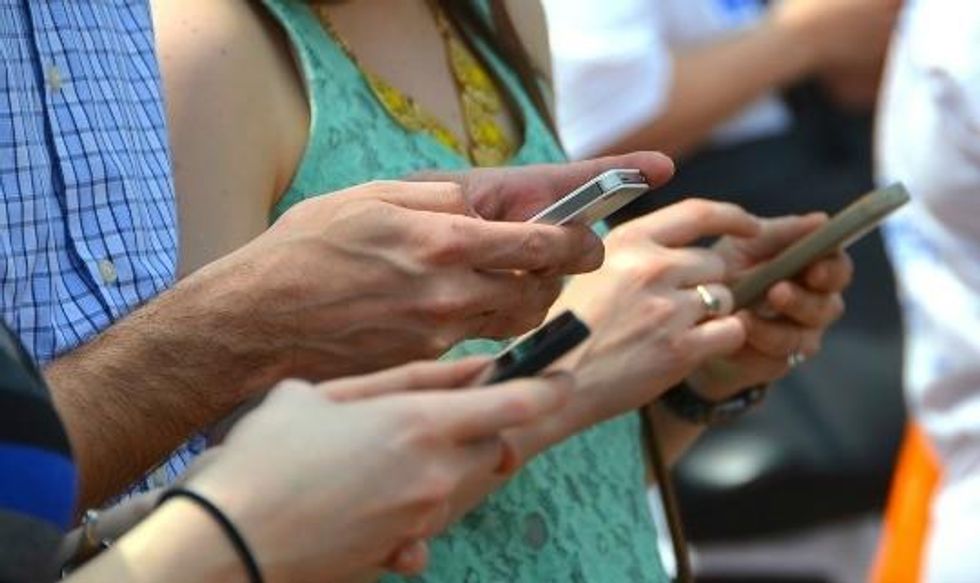'A Goldmine to Exploit': NSA Vacuuming Up Millions of Text Messages Daily
The Guardian and Channel 4 News report on the newest revelation of NSA's vast surveillance

This newest revelation about the NSA's vast surveillance made possible by documents leaked from whistleblower Edward Snowden exposes a program of untargeted collection called "Dishfire."
Dishfire collects "pretty much everything it can," one of the documents stated.
Dishfire's vast database of messages allowed the NSA to extract names, information from missed calls, credit card numbers, data from electronic business cards, financial transactions, details of border crossings, travel information and geolocation information.
A top secret presentation on the program provided by Snowden and dated 2011 is subtitled "SMS Text Messages: A Goldmine to Exploit."
Further, the Guardian and Channel 4 News report that the NSA's British counterpart, the GCHQ, was given access to this database.
Because the NSA is not required to delete UK numbers, the GCHQ had access to vast amounts of metadata on untargeted numbers.
By being given access to the NSA's trove of data, the GCHQ could skirt British law which requires it to obtain Regulation of Investigatory Powers Act permission before getting access to UK numbers.
"This makes it particularly useful for development of new targets, since it is possible to examine the content of messages sent months or even years before the target was known to be of interest," the Guardian and Channel 4 News report one of the documents as stating.
The news of text message surveillance comes a day ahead of a speech by President Obama on proposed reforms to the NSA, in which critics predict he will not go nearly far enough to rein in the government surveillance.
Channel 4 News produced this 8-minute video to accompany the report:
_____________________
An Urgent Message From Our Co-Founder
Dear Common Dreams reader, The U.S. is on a fast track to authoritarianism like nothing I've ever seen. Meanwhile, corporate news outlets are utterly capitulating to Trump, twisting their coverage to avoid drawing his ire while lining up to stuff cash in his pockets. That's why I believe that Common Dreams is doing the best and most consequential reporting that we've ever done. Our small but mighty team is a progressive reporting powerhouse, covering the news every day that the corporate media never will. Our mission has always been simple: To inform. To inspire. And to ignite change for the common good. Now here's the key piece that I want all our readers to understand: None of this would be possible without your financial support. That's not just some fundraising cliche. It's the absolute and literal truth. We don't accept corporate advertising and never will. We don't have a paywall because we don't think people should be blocked from critical news based on their ability to pay. Everything we do is funded by the donations of readers like you. Will you donate now to help power the nonprofit, independent reporting of Common Dreams? Thank you for being a vital member of our community. Together, we can keep independent journalism alive when it’s needed most. - Craig Brown, Co-founder |

This newest revelation about the NSA's vast surveillance made possible by documents leaked from whistleblower Edward Snowden exposes a program of untargeted collection called "Dishfire."
Dishfire collects "pretty much everything it can," one of the documents stated.
Dishfire's vast database of messages allowed the NSA to extract names, information from missed calls, credit card numbers, data from electronic business cards, financial transactions, details of border crossings, travel information and geolocation information.
A top secret presentation on the program provided by Snowden and dated 2011 is subtitled "SMS Text Messages: A Goldmine to Exploit."
Further, the Guardian and Channel 4 News report that the NSA's British counterpart, the GCHQ, was given access to this database.
Because the NSA is not required to delete UK numbers, the GCHQ had access to vast amounts of metadata on untargeted numbers.
By being given access to the NSA's trove of data, the GCHQ could skirt British law which requires it to obtain Regulation of Investigatory Powers Act permission before getting access to UK numbers.
"This makes it particularly useful for development of new targets, since it is possible to examine the content of messages sent months or even years before the target was known to be of interest," the Guardian and Channel 4 News report one of the documents as stating.
The news of text message surveillance comes a day ahead of a speech by President Obama on proposed reforms to the NSA, in which critics predict he will not go nearly far enough to rein in the government surveillance.
Channel 4 News produced this 8-minute video to accompany the report:
_____________________

This newest revelation about the NSA's vast surveillance made possible by documents leaked from whistleblower Edward Snowden exposes a program of untargeted collection called "Dishfire."
Dishfire collects "pretty much everything it can," one of the documents stated.
Dishfire's vast database of messages allowed the NSA to extract names, information from missed calls, credit card numbers, data from electronic business cards, financial transactions, details of border crossings, travel information and geolocation information.
A top secret presentation on the program provided by Snowden and dated 2011 is subtitled "SMS Text Messages: A Goldmine to Exploit."
Further, the Guardian and Channel 4 News report that the NSA's British counterpart, the GCHQ, was given access to this database.
Because the NSA is not required to delete UK numbers, the GCHQ had access to vast amounts of metadata on untargeted numbers.
By being given access to the NSA's trove of data, the GCHQ could skirt British law which requires it to obtain Regulation of Investigatory Powers Act permission before getting access to UK numbers.
"This makes it particularly useful for development of new targets, since it is possible to examine the content of messages sent months or even years before the target was known to be of interest," the Guardian and Channel 4 News report one of the documents as stating.
The news of text message surveillance comes a day ahead of a speech by President Obama on proposed reforms to the NSA, in which critics predict he will not go nearly far enough to rein in the government surveillance.
Channel 4 News produced this 8-minute video to accompany the report:
_____________________

